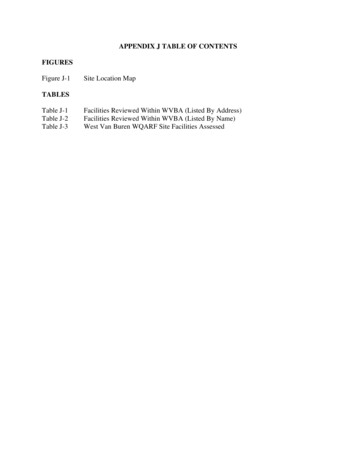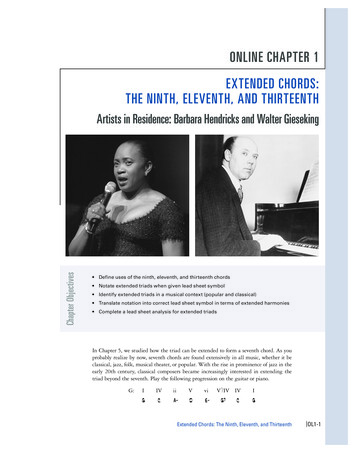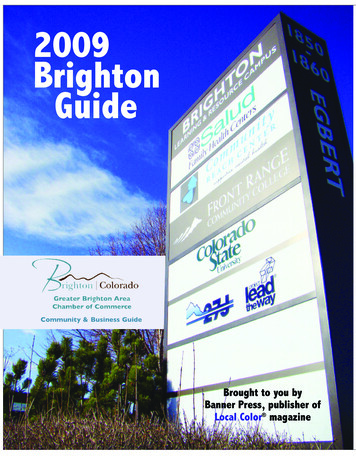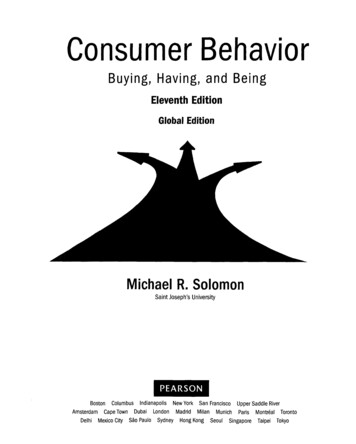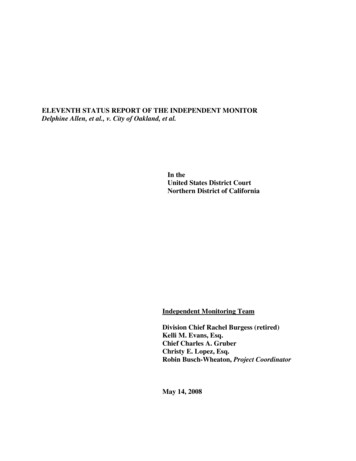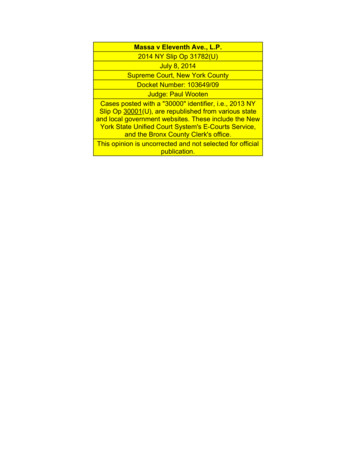
Transcription
Massa v Eleventh Ave., L.P.2014 NY Slip Op 31782(U)July 8, 2014Supreme Court, New York CountyDocket Number: 103649/09Judge: Paul WootenCases posted with a "30000" identifier, i.e., 2013 NYSlip Op 30001(U), are republished from various stateand local government websites. These include the NewYork State Unified Court System's E-Courts Service,and the Bronx County Clerk's office.This opinion is uncorrected and not selected for officialpublication.
[* 1],./SUPREME COURT OF THE STATE OF NEW YORK PRESENT:NEW YORK COUNTYHON. PAUL WOOTENJusticePART 7THOMAS MASSA,Plaintiff,103649/09INDEX NO.-against-004MOTION SEQ. NO.ELEVENTH AVENUE, LP., JEFFREY E. LEVINEFAMILY LIMITED PARTNERSHIP, DD 11TH AVEf.{UE,LLC, TOTAL SAFETY CONSULTING, LLC, J.E. 4EVltJFBUILDER INC., d/b/a LEVINE BUILDERS, S.J. iELECTRIC, INC., STAR-DELTA ELECTRIC, LLq al)dPAR PLUMBING CO.,IlLEDi'fI!JUL 1 1 2014Defendants.The following papers were read on this motion byNEW YORK. nt.----Notice of Motion/ Order to Show Cause - Affidavits Answering Affidavits -.,.PAPERS NUMBEREDExhibits .Exhibits (Memo)Replying Affidavits (Reply Memo). .Cross-Motion: YesD NoThis is an action to recover damages for personal injuries sustained by a laborer onAugust 27, 2008, when he tripped and fell over some electrical pipe protruding up from apoured concrete floor while working at a construction site located at 312 Eleventh Avenue, NewYork, New York (the premises)./Defendants Eleventh Avenue, L.P. (Eleventh), Jeffrey E. Levine Family LimitedPartnership (Levine Family), DD 11 1h Avenue, LLC (DD 11 1h), Total Safety Consulting, LLC(Total Safety), J.E. Levine Builder Inc. d/b/a Levine Builders (Levine Builders) and Par PlumbingCo. (Par Plumbing) (collectively, defendants) move, pursuant to GPLR 3212, for summaryjudgment dismissing plaintiff Thomas.Massa's complaint 1 as weHas all cross-claims asserted\'·,,·-.·.Page 1 of 17-,\'.-·'
[* 2]against them. Defendant S.J. Electric, Inc. (SJ Electric) cross-moves, pursuant to CPLR 3212,for summary judgment dismissing the complaint and all cross-claims asserted against it.BACKGROUNDOn the day of the accident, Eleventh was the ground lessor on a 99-year ground leasefor the premises, and DD 11th was the ground lessee. Levine Builders served as constructionmanager at the premises on a project which involved the new construction of a 34-story buildingwith 368 residential units, a parking garage and retail space. Levine Builders hired nonpartyCross County Construction LLC (Cross County), plaintiff's employer, to perform superstructureconcrete work at the premises. In addition, Levine hired Total Safety to serve as a safetyconsultant on the project, Par Plumbing to provide new plumbing installations and SJ Electric toperform electric and fire alarm work on the project. Levine Family had no ownership interest,management function or other involvement with the premises on the day of the accident.Plaintiff's Deposition TestimonyPlaintiff testified that on the day of the accident he was employed by Cross County as ageneral laborer. Plaintiff explained that his job at the site was to bring the carpenters workingon the project any tools or materials needed to perform their work. Plaintiff testified that hereceived all his supervision, instructions and directions from either one of the Cross Countyforemen or the owner of the premises.Plaintiff testified that his accident occurred while he was working on the second floor ofthe premises. At this time, electricians and plumbers were also working on the second floor.As he was walking to a gang ladder on his way to pass up to other workers the three 2x4s hewas carrying on his right shoulder, he tripped and fell over four aluminum electrical pipes, whichwere held together in the middle by a brace, and which protruded approximately two feet upfrom the concrete floor (the stub-up). Each pipe was gray in color and approximately a half ofan inch in diameter. Plaintiff maintained that there were no cones or warnings in place to warnPage 2 of 17
[* 3]of the stub-up's presence, and that the stub-up had been present in the accident area forbetween a week and a month prior to the time of the accident.Plaintiff further testified that he recognized the stub-up to be an electrical conduit fromhis experience in working in the construction industry. These types of conduits, which werecommon at the site, were used by the electricians on the project to run wires. Plaintiff, who hadgeneral knowledge that various stub-ups were present on the floor, was looking "forward,because all these guys were working on the floors, and [he] didn't want to hit anybody" (SJElectric's opposition, exhibit A, plaintiff's tr at 102)Deposition Testimony of Anthony Rappa SJ Electric's General SuperintendentAnthony Rappa (Rappa) testified that he served as SJ Electric's general superintendenton the project SJ Electric was hired by Levine Builders to install the electrical wiring, conduitsand power sources for the building. Rappa testified that low voltage wiring for the project wasperformed by a different electrical contractor on the project. At the time of the accident, andprior to the concrete pours, SJ Electric, the plumbers and the steamfitters on the project allinstalled conduits in the building's floors. Rappa explained that the conduits, or cylindersleeves, installed by SJ Electric, were never made of aluminum, but rather, they were made ofelectro-magnetic tubing, galvanized steel or plastic.Rappa testified that he typically avoided using stub-ups, which protrude upwards fromthe concrete floor, because they were susceptible to damage during construction. For thisreason, Rappa preferred to use stub-downs, which were conduits which ran down from theceiling. When it did become necessary to use a stub-up, SJ Electric installed them so that theyonly protruded six to seven inches from the floor.During his deposition, and after reviewing the building's construction plans, RappaPage 3 of 17
[* 4]testified that, while he could identify a stub-up installed on the second floor, it was concealed ina wall, and thus, it was not a tripping hazard. Rappa also testified that, in the event that any ofSJ Electric's conduits did protrude up from the surface of tl1e floor, "[m)y guys go around andspray everyone of my [stub-ups] orange, so that there is no damage [to them]" (SJ Electric'sopposition, exhibit B, Rappa tr at 65).Deposition Testimony of Patrick Cannone,SJ Electric WorkerPatrick Cannone (Cannone) testified that he was employed by SJ Electric as anelectrician on the day of the accident. Cannone explained that SJ Electric used an assortmentof conduit on the project, such as "[g)alvanized pipe, aluminum pipe, EMT and plastic" (SJElectric's opposition, exhibit C, Cannone tr at 16). He explained that approximately 85 %, or the"majority" of SJ Electric's conduits, are stub-downs (id. at 20). He noted that SJ Electric wouldonly use aluminum conduits for outdoor purposes, where the use of the metal was necessary toprotect the conduits against the weather. Cannone asserted that "[SJ Electric] never install[ed]it in concrete . we used plastic pipe for that" (id. at 27-28).Deposition Testimony of James Stankes, SJ Electric WorkerJames Stankes (Stankes) testified that he was employed as a worker by SJ Electric onthe day of the accident. His duties included installing pipes and cables for the electrical work atthe premises. He explained that SJ Electric "ran conduits for the feeds for the panels" (SJElectric opposition, exhibit D, Stankes tr at 10). He described the types of conduit used by SJElectric as sometimes including "three-quarter to four-inch EMT aluminum," as well as electromagnetic tubing and galvanized steel (id.). He testified that the only stub-ups coming out of thefloor on the second floor of the building on the day of the accident were located against a sheerwall behind an elevator shaft, and therefore, they were not tripping hazards. He maintained thatPage 4 of 17
[* 5]tripping hazards at the site were usually sprayed red by either the general contractor or SJElectric in order to make them more visible to workers.Deposition Testimony of Riso Ramusevic, Employed by LBDD Resource Inc.Riso Ramusevic (Ramusevic) testified that he was employed by nonparty LBDDResource Inc. (LBDD) on the day of the accident. LBDD was hired by Levine Builders toprovide risk management and safety consulting services to Levine Builders. Ramusevictestified that stub-ups wereus dby SJ Electric, as well as steamfitters, control electricians.plumbers and HVAC subcontractors at the project Ramusevic explained that the installation ofa stub-up or conduit is an integral part of construction "just like a wall is" (SJ Electric'sopposition, exhibit E, Ramusevic tr at 43). He further explained that stub-ups are "basically asleeve that would act as a conduit to travel through floors whether its piping or electrical wires"id. at 31 ). The stub-ups are sometimes spray-painted for safety reasons. Ramusevic testifiedthat, depending on the contract requirements, "sometimes . the trade contractors would[spray the stub-ups]," as they "are responsible for their means and method with respect tosafety" (id. at 43, 45).Deposition Testimony of Fred Milteer, Total Safety Construction Site Safety ManagerFred Milteer (Milteer) testified that he was a construction site safety manager employedby Total Safety on the day of the accident As site safety manager, Milteer inspected the floorsof the premises each day. In August of 2008, the floors of the building were still wide open, asno interior walls had yet been built Milteer testified that, if he had observed a tripping hazard,he would have noted it in his daily report, and that the report from the day of the accident didnot advise of any tripping hazards on the second floor of the building. He also noted that thepipes on each floor ran close to the walls, and thus, they did not pose a tripping hazard. In anyPage 5 of 17
[* 6]event, if there were a conduit coming up from the floor, it was often surrounded by rebar or theywould be spray-painted orange to make them more visible to the workers.Deposition Testimony of Lawrence Frawley, Par Plumbing SupervisorLawrence Frawley (Frawley) testified that he served as Par Plumbing's supervisor fornew construction on the day of the accident. As such, he "check[ed] the projects daily"(defendants' notice of motion, exhibit I, F:rawley tr at 8)to "install all new plumbing systems" (id at 10).Par Plumbing's role at the project wasPrior to the day of the accident, with theexception of Par Plumbing's installation of temporary copper pipes for water, Par Plumbing hadnot yet installed any pipes on the second floor of the premises. However, several weeks beforethe deck of the second floor was completed, and prior to Par Plumbing's installation of its pipes,Par Plumbing placed sleeves in the deck, "[s}o a pipe can pass through [them]" (id. at 17).Frawley maintained that Par Plumbing did not use any aluminum pipes on the project. The onlytrade that used aluminum pipes was the electrical trade.Deposition Testimony of James Costigan, Supervisor for Cross CountyJames Costigan (Costigan) testified that he was one of plaintiff's Cross Countysupervisors on the day of the accident. Costigan testified that SJ Electric was the electricalsubcontractor on the project, and that he observed SJ Electric installing conduits in the floors ofthe building. When asked to describe the kind of pipes that SJ Electric used on the project.Costigan described them as "rigid metal pipe that they install on the floor, and sometimes theycome out of the floor, so they could run wires through those pipes" (defendants' notice ofmotion, exhibit L, Costigan tr at 11 ). He also described said pipes as ranging from threequarters of an inch in diameter to four-inches in diameter, protruding approximately 12 inchesfrom the surface of the floor. Costigan maintained that plaintiff tripped over metal coloredPage 6 of 17
[* 7]pipes.DISCUSSIONSummary judgment is a drastic remedy that should be granted only if no triable issues offact exist and the movant is entitled to judgment as a matter of law (See Alvarez v ProspectHosp., 68 NY2d 320, 324 [1986]; Andre vPomeroy, 35 NY2d 361, 364 [1974]). The partymoving for summary judgment must make a prima facie showing of entitlement to judgment asa matter of law, tendering sufficient evidence in admissible form demonstrating the absence ofmaterial issues of fact (see Winegrad v New York Univ. Med. Ctr., 64 NY2d 851, 853 [1985];CPLR 3212[b]). A failure to make such a showing requires denial of the motion, regardless ofthe sufficiency of the opposing papers (see Smalls v AJI Inc/us. Inc., 10 NY3d 733, 735 [2008]).Once a prima facie showing has been made, however, "the burden shifts to the nonmovingparty to produce evidentiary proof in admissible form sufficient to establish the existence ofmaterial issues of fact that require a trial for resolution" (Giuffrida v Citibank Corp., 100 NY2d72, 81 [2003]; see also Zuckerman v City of New York, 49 NY2d 557, 562 [ 1980]; CPLR3212[b])When deciding a summary judgment motion, the Court's role is solely to determine ifany triable issues exist, not to determine the merits of any such issues (see Sillman v TwentiethCentruy-Fox Film Corp., 3 NY2d 395, 404 [1957]). The Court views the evidence in the lightmost favorable to the nonmoving party, and gives the nonmoving party the benefit of allreasonable inferences that can be drawn from the evidence (see Negri v Stop & Shop, Inc., 65NY2d 625, 626 [1985]). If there is any doubt as to the existence of a triable issue, summaryjudgment should be denied (see Rotuba Extruders, Inc. v Ceppos, 46 NY2d 223, 231 [1978]).Page 7 of 17
[* 8]Plaintiff's Labor Law§ 241(6) Claim Against Defendants and SJ ElectricLabor Law § 241 (6) provides, in pertinent part, as follows:"All contractors and owners and their agents . when constructingor demolishing buildings or doing any excavating in connectiontherewith, shall comply with the following requirements:***(6)All areas in which construction, excavation or demolitionwork is being performed shall be so constructed, shored,equipped . as to provide reasonable and adequateprotection and safety to the persons employed therein orlawfully frequenting such places . "Labor Law § 241 (6) imposes a nondelegable duty on owners and contractors to providereasonable and adequate protection and safety to workers (see Ross v Curtis-Palmer HydroElec. Co., 81 NY2d 494, 501-502 [1993]). However, Labor Law§ 241 (6) is not self-executing,and in order to show a violation of this statute, and withstand a defendant's motion for summaryjudgment, it must be shown that the defendant violated a specific, applicable, implementingregulation of the Industrial Code, rather than a provision containing only generalizedrequirements for worker safety (id.).Although plaintiff lists multiple violations of the Industrial Code in his bill of particulars,with the exception of Industrial Code sections 23-1.7(e)(1) and (2), plaintiff does not addressthese Industrial Code violations in his opposition papers, and thus, they are deemed abandoned(see Gary v Flair Beverage Corp., 60 AD3d 413, 413 [1st Dept 2009) ["Indeed, plaintiff's failureto address this issue in its responding brief indicates an intention to abandon this basis ofliability"]; Genovese v Gambino, 309 AD2d 832, 833 [2d Dept 2003] [where plaintiff did notoppose that branch of defendants' summary judgment motion dismissing the wrongfultermination cause of action, his claim that he was wrongfully terminated was deemedPage 8 of 17
[* 9]abandoned]; Musil/a v Marist College, 306 AD2d 782, 784 n [3d Dept 2003]). As such,defendants and SJ Electric are entitled to summary judgment dismissing plaintiff's Labor· Law§241 (6) claim predicated on those abandoned provisions.Initially, Eleventh Avenue, as owner of the premises, may be subjected to Labor Law§241 (6) liability. However, it must be determined as to whether Levine Builders, Levine Family,DD 11th, Total Safety, Par Plumbing and SJ Electric may be vicariously liable for plaintiff'sinjuries under Labor Law § 241 (6) as agents of the owner. "When the work giving rise to [theduty to conform to the requirements of Labor Law§ 241 (6)] has been delegated to a third party,that third party then obtains the concomitant auH1ority to supervise and control that work andbecomes a statutory 'agent' of the owner or general contractor" (Russin v Louis N. Picciano &Son, 54 NY2d 311, 318 [1981]).Initially, a review of the facts in this case indicates that Levine Builders, Levine Family,DD 11th and Total Safety did not have sufficient authority to supervise and control the injuryproducing work at issue, i.e., the installation of the stub-up, so as to be held vicariously liable forplaintiff's injuries as a statutory agent of the owner under Labor Law' 241 (6) (see Waifs v,Turner Constr. Co., 4 NY3d 861, 864 [2005] [Court noted that defendant Turner was not atypical construction manager, because it had "broad responsibility" as a "coordinator and overallsupervisor for all the work being perfoni1ed on the job site," including the plaintiff's work]).Thus, these defendants are entitled to summary judgment dismissing plaintiff's Labor Law§241 (6) claim against them.As to Par Plumbing, testimonial evidence in the record suggests that the plumbers andsteamfitters on the project, which were present on the second floor at the time of the accident,also installed conduits and piping in the floors of the building. Frawley, the Par PlumbingPage 9 of 17
[* 10]supervisor, testified that several weeks before the deck of the second floor was completed, andprior to Par Plumbing's installation of its pipes, Par Plumbing placed sleeves in the deck, "[s]o apipe can pass through [them]" (defendants' notice of motion, exhibit I, Frawley tr at 17).Tt1us,a question of fact exists as to whether Par Plumbing's conduit caused plaintiff to trip and fall(defendants' notice of motion, exhibit I, Frawley tr at 17).In addition. the conflicting testimony in the record regarding the heights and locations ofSJ Electric's stub-ups at the sit,e, as well as the material they were comprised of, creates aquestion of fact as to whether SJ Electric was the entity responsible for installing the stub-upthat caused the accident. Thus, as questions of fact exist as to whether Par Plumbing and/orSJ Electric supervised and controlled the injury-producing work, these defendants are notentitled to summary judgment dismissing that part of plaintiff's Labor Law§ 241 (6) claimpredicated on an alleged violation of section 23-1. 7( e )(1) and (2) on the ground that they werenot an agent of the owner for the purposes of the statute.Industrial Code 12 NYCRR 23-17(e)(1) and (2)Industrial Code 12 NYCRR 23-1.7(e)(1) and (2) are sufficiently specific to sustain aclaim under Labor Law§ 241 (6) (see O'Sullivan v IOI Constr. Co., Inc , 28 AD3d 225, 225 [1stDept 2006], affd 7 NY3d 805 [2006], Appelbaum v 100 Church, 6 AD3d 310, 310 [1st Dept2004]; Vieira v Tishman Constr. Corp., 255 AD2d 235, 235 [1st Dept 1998]).Industrial Code 12 NYCRR 23-1.7(e)(1) and (2) provide, in pertinent part:(e) Tripping and other hazards( 1)Passageways. All passageways shall be kept free from . debrisand from any other obstructions or conditions which could causetripping.***(2)Working Areas. The parts of floors, platforms and similar areasPage10of 17
[* 11]where persons wixk or pass shall be kept free from . debris .insofar as may be consistent with the work being performed.Here. Industrial Code 12 NYCRF 23-1.7(e)(1) does not apply to the facts of this case,as plaintiff's accident did not occur in a passageway, but in an open working area (Vere! vFerguson Elec. Constr. Co., Inc., 41 AD3d 1154, 1157 [4th Dept 2007]; O'Sullivan v IOI Constr.Co., Inc., 28 AD3d at 225-226; Appelbaum v 100 Church, 6 AD3d at 310; Vieira v TishmanConstr. Corp., 255 AD2d at 235 [no Industrial Code 12 NYC RR 23-1. 7(e)(1) violation whereplaintiff was not injured in a passageway but while working in an open area]).To that effect, a review of the testimonial evidence in this case reveals that the floors ofthe building on the day of the accident were still wide open, as no interior walls had yet beenbuilt. In his opposition to defendants' motion, and in support of his argument that a question offact exists as to whether the location where he was injured was a passageway, plaintiff putsforth only the following testimony:Q.Was there a specific path that you were walking along? How was thefloor laid out?A.I don't know. It's just an opening of the building, just walk into it(plaintiff's notice of cross-motion, exhibit, plaintiff's tr at 35). However, a further reading ofplaintiff's testimony reveals that plaintiff continued his testimony, as follows:Q.The second floor, were there walls up?A.No walls, no.Q.So the entire second floor was open. Could you see from one end of thesecond floor to the other end of the second floor?A.That's straight, but there might be a wall in the middle, but there was nowall on the outside of the building (id. at 35-36).In addition, while plaintiff's accident occurred in a working area, as required by IndustrialPage 11 of 17
[* 12]Code 12 NYCRR 23-1.7(e)(2), this section is inapplicable to the facts of this case, as the stubup that plaintiff allegedly tripped on was an integral part of the work being performed at the siteof his accident (O'Sullivan v IOI Constr. Co., 7 NY3d 805, 805 [2006] [electrical pipe or conduitthat plaintiff tripped over was an integral part of the construction]; Cumberland v Hines InterestsLtd. Partnership, 105 AD3d 465, 465 ['I st Dept 2013] [section 23-1. 7(e)(2) did not apply wl1erethe pipe and pipe fittings that plaintiff tripped over were consistent with the work beingperformed in the room]; Vere/ v Ferguson Elec. Constr. Co . Inc., 41 AD3d at 1157 [electricalconduits, which were protruding from the concrete floor of a building under construction andthat the plaintiff tripped over, were integral part of the construction going on at the project site];Tucker v Tish man Constr. Corp. of N. Y, 36 AD3d 417, 417 [1st Dept 2007] [re bar steel that theplaintiff tripped over was not debris, scattered tools and materials, or a sharp projection, butrather, it was an integral part of the work being performed]; Dubin v S. OiFazio & Sons Constr,Inc., 34 AD3d 626, 626 [2d Dept 2006]; Appelbaum v 100 Church, 6 AD3d 310, 310 [1st Dept2004]; Salinas v Barney Skanska Constr. Co, 2 AD3d 619, 622 [2d Dept 2003] [section 231.7(e)(2) inapplicable where plaintiff testified that he tripped over demolition debris created byhim and his coworkers, which was an integral part of the work being performed]; Bond v YorkHunter Constr., 270 AD2d 112, 113 [1st Dept 2000], affd 95 NY2d 883 [2000] ["theaccumulation of debris was an unavoidable and inherent result of work at an on-goingdemolition project, and therefore provides no basis for imposing liability"]; Vieira v TishmanConstr Corp., 255 AD2d at 235 [section 23-1.7(e)(2) did not apply where the plaintiff trippedover wire mesh installed on top of a metal grid, where mesh became part of the structure of thefloor once the concrete was poured on top of it]). As stated by Ramusevic, the installation ofconduit is an integral part of construction "just like a wall is" (SJ Electric's opposition, exhibit E,Page12of 17
[* 13]Ramusevic tr at 43).Thus, defendants and SJ Electric are entitled to summary judgment dismissing that partof plaintiff's Labor Law§ 241 (6) claim predicated on alleged violations of Industrial Code 12NYCRR 23-1.7(e)(1) and (2).Plaintiff's Common-law Negligence c;fnd Labor Law§ 200 ClaimsLabor Law § 200 is a "'codification of the common-law duty imposed upon an owner orgeneral contractor to provide construction site workers with a safe place to work' [citationomitted]" (Cruz v Toscano, 269 AD2d 122, 122 [1st Dept 2000]; see also Russin v Louis NPicciano & Son, 54 NY2d at 316-317). "It is well settled that an implicit precondition to this dutyis that the party to be charged with that obligation 'have the authority to control the activitybringing about the injwy to enable it to avoid and correct an unsafe condition"' (Rizzuto v L.A.Wenger Contr. Co., 91 NY2d 343, 352 [1998], quoting Russin v Picciano & Son, 54 NY2d at317). Labor Law§ 200(1) states, in pertinent part, as follows:"1. All places to which this chapter applies shall be so constructed, equipped,arranged, operated and conducted as to provide reasonable and adequateprotection to the lives, health and safety of all persons employed therein orlawfully frequenting such places. All machinery, equipment, and devices in suchplaces shall be so placed, operated, guarded, and lighted as to providereasonable and adequate protection to all such persons.There are two distinct standards applicable to section 200 cases, depending on the kindof situation involved: when the accident is the result of the means and methods used by thecontractor to do its work, and when the accident is the result of a dangerous condition (seeMcLeod v Corporation of Presiding Bishop of Church of Jesus Christ of Latter Day Sts., 41AD3d 796, 797-798 [2d Dept 2007]).The accident at issue in this case was caused due to an unsafe condition at thepremises constituting a tripping hazard, i.e., the presence of the stub-up, which protruded upPage13of 17
[* 14]from the surface of the floor, and which was not marked in such a way as to warn of itspresence. "Where an existing defect or dangerous condition caused the injury, liability [underLabor Law § 200] attaches if the owner or general contractor created the condition or hadactual or constructive notice of it" (Cappabianca v Skanska USA Bldg. Inc., 99 AD3d 139, 144[1st Dept 2012]; Murphy v Columbia Univ., 4 AD3d 200, 202 [1st Dept 2004] [to support afinding of a Labor Law§ 200 violation, it was not necessary to prove general contractor'ssupervision and control over plaintiff's work, because the injury arose from the condition of thework place created by or known to contractor, rather than the method of the work]). Therefore,in order for defendants to be liable under common-law negligence and Labor Law § 200theories, it must be shown that defendants either created the alleged unsafe condition byinstalling the stub-up and then failing to mark it in such a way as to warn of its presence, or thatthey had actual or constructive notice of the unsafe condition.Initially, Levine Family is entitled to dismissal of the common-law negligence and LaborLaw§ 200 claims against it, because it has not been disputed that it had no ownership interest,management function or other involvement with the premises on the day of the accident. Inaddition, as discussed previously, as questions of fact exist as to whether defendant ParPlumbing or defendant SJ Electric created the alleged unsafe condition, these defendants arenot entitled to summary judgement disniissing plaintiff's common-law negligence and LaborLaw§ 200 claims against them (see Cappabianca v Skanska USA Bldg. Inc, 99 AD3d at 144;Murphy v Columbia Univ., 4 AD3d at 202).As to the remaining defendants, Eleventh, DD 11th, Total Safety and Levine Builders,the record is devoid of any evidence that these defendants either created or had actual noticeof the stub-up's presence in the accident area, such that they could be charged with thePage14of17
[* 15]responsibility to mark it so as to make it safe for workers. However, a question of fact exists asto whether these defendants had constructive notice of the unsafe condition. The Court ofAppeals has long held that "[t)o constitute constructive notice, a defect must be visible andapparent and it must exist for a sufficient length of time prior to the accident to permitdefendant's employees to discover and remedy it" (Gordon v American Museum of NaturalHistory, 67 NY2d 836, 837 [1986)).Witnesses for defendants and SJ Electric testified that most of its conduits at thepremises were stub-downs which were installed within or near walls, and thus, they were nottripping hazards. In addition, Milteer of Total Safety testified that he inspected the floors of thepremises each day, and that if he had noticed a tripping hazard. he would have included it in hisreport, which he did not. However, as put forth by plaintiff in support of his argument thatdefendants should be charged with constructive notice, plaintiff testified that the stub-up that hetripped over was in place approximately one week to one month before the date of plaintiff'saccident, ample time for defendants to discover and remedy it. In addition, the record containstestimony to the effect that it was sometimes necessary for stub-ups to be installed in workingareas.Thus, as a question of fact exists as to whether these defendants had constructivenotice of the unsafe condition, they are not entitled to summary judgment dismissing plaintiff'scommon-law negligence and Labor Law§ 200 claims against them.Finally, it should be noted that defendants argue that. due to the open and obviousnature of the unsafe condition at issue in this case, the duty to provide a safe place to workdoes not apply. However, liability under Labor Law § 200 is not negated by plaintiff'sawareness that the stub-up may have been present at the location of his accident, or by thePage 15 of 17
[* 16]open and obvious nature of this allegedly unsafe condition, as these factors merely go toplaintiff's comparative negligence (DeJesus v F.J. Sciame Constr. Co., Inc., 20 AD3d 354, 354[1st Dept 2005) [although raised metal door frame on which plaintiff tripped was open, obviousand readily observable, this fact only eliminated the defendant contractor's duty to warn of thehazardous condition and did not negate the broader du
Massa v Eleventh Ave., L.P. 2014 NY Slip Op 31782(U) July 8, 2014 Supreme Court, New York County Docket Number: 103649/09 Judge: Paul Wooten Cases posted with a "30000" identifier, i.e., 2013 NY Slip Op 30001(U), are republished from various state and local government websites. These include the New York State Unified Court System's E-Courts .
